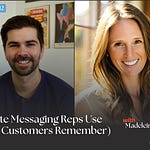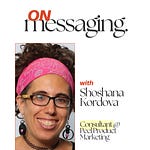Listen now on YouTube, Spotify, and Apple Podcasts!
On the show today, I have Emily Pick, Lead Product Marketing Manager at Clari.
As I listened back to my conversation with Emily, I was blown away at her depth of knowledge in product marketing and messaging. This is advanced level material if we’re putting it on a scale of learning. I took a copious amount of notes during this chat.
During our conversation, you’ll learn:
How to influence the product roadmap as a product marketer
Why most B2B messaging gets stuck in feature-function battles
How to create messaging for buying committees without losing clarity
How to transition from single-product messaging to platform-level narratives
And so much more.
Key Points From my Conversation with Emily
1. B2B Messaging needs to evolve Beyond just Product Features
B2B messaging often gets bogged down in feature and function battles, but customers aren't buying products; they're buying solutions to their pain.
The key is to focus on the customer's "revenue objectives" and the problems they are trying to solve. Messaging should anchor on how the platform or solution can alleviate specific pains and enable customers to achieve their goals, rather than simply listing product functionalities.
This approach helps in building trust and demonstrating a deeper understanding of the customer's challenges.
2. How Companies like Clari Transition from Single-product Messaging to a Broader Platform Narrative
Many companies, especially those known for a niche product, are moving towards platform-level narratives as they expand their offerings.
Clari, initially known for forecasting, is transitioning to being known as a "Revenue Action Orchestration Platform." This involves framing to the overarching goal, aka achieving predictable revenue growth, and showing how the platform brings together various capabilities (like forecasting, conversation intelligence, and sales engagement) to address this goal.
The core idea is to lead with the platform's ability to solve higher-level business objectives, with individual products serving as supporting elements of these solutions.
3. The Distinction Between Positioning and Branding in Platform-level Messaging
Positioning defines how a company wants to be perceived by the market, serving as the "North Star" for all communications.
Branding, on the other hand, reinforces that position through visuals, creative elements, and copy. Positioning influences the messaging, which then influences the brand, ensuring a cohesive story.
For Clari, their positioning as a leader in revenue intelligence and context-driven predictability guides all their branding and messaging efforts.
4. How Clari Prioritizes Different Types of Product Launches and Marketing Efforts
Clari uses a dual-scoring system for product launches: a "customer impact score" (low, medium, high) and a "product launch tier" (Tier 1, 2, 3).
These two scores are not always aligned. For a Tier 1 launch with a low customer impact (like consumption forecasting, which appealed to a niche market), marketing activities begin 2-3 months out due to extensive cross-functional collaboration. For features with high customer impact but a lower launch tier (like self-serve forecast configuration), marketing starts closer to the beta stage, often focusing on customer newsletters and direct communication rather than broad market campaigns.
This allows for targeted messaging based on audience and business impact.
5. How Product Marketers Influence the Product Roadmap
Influencing the product roadmap largely depends on the stage of the roadmap and the product marketer's relationship with product managers.
Key strategies include bringing market and customer insights, joining customer conversations, leveraging analyst research (e.g., from tools like Wynter), and participating in alpha and beta programs.
By gathering and presenting valuable feedback on what customers care about and how new features align with the larger product and company vision, product marketers can effectively guide development so products address real market needs.
6. How Emily Tailors Messaging for Different Stakeholders within a Buying Committee
Clari focuses on tailoring messages to specific personas based on the solution and their "revenue objectives."
While they excel at speaking to senior leadership (CROs, VPs of Sales, RevOps leaders), they've recognized a need to improve messaging for frontline users and managers (reps, SDRs). They map the solutions, use cases, and jobs to be done for each role. They align their messaging efforts with campaigns run by their revenue team, so content, assets, and collateral are specific to the target persona and user group.
The primary focus remains on the "financial decision makers" (those with budget), but assets and resources are also provided to frontline users to drive platform adoption and advocacy.
7. Emily’s Most Impactful Messaging Advice for Product Marketers
The most impactful messaging advice is to "listen to your customers, find their words, and start using them."
Marketers should avoid jargon and "marketing speak" like "actionable insights" or "leverage," and instead adopt the language their buyers naturally use. Customer feedback from webinars, testimonials, and tools like UserEvidence or Laudable provides a goldmine of authentic language.
Integrating this customer-centric language into messaging ensures resonance and prevents buyers from tuning out due to overly corporate or generic communication.
In our conversation, we cover:
00:00 – Nobody’s buying a product—they’re buying a solution to their pain
00:29 – Intro to the episode and what you’ll learn from Emily
01:23 – Emily joins the show and shares her love for messaging
02:26 – Why Emily stepped away from business books and back into travel stories
03:17 – Backpacking, Rick Steves, and what travel taught Emily
06:26 – Travelers, chaos, and the joy of unpredictable experiences
07:20 – Introduction to platform vs. product messaging
07:56 – The history of Clari and their transition to a revenue platform
09:18 – Defining your category: what Clari wants to be known for
12:02 – Using positioning as the North Star for platform messaging
12:42 – Positioning vs. branding: how Emily differentiates the two
13:37 – Platform-first vs. product-level messaging strategy
14:08 – Moving from product features to solution-based messaging
16:01 – When product-specific messaging becomes important
16:54 – Mapping solutions to pains and personas before products
17:47 – Aligning product launches to the company narrative
18:36 – Crafting baseline and higher-order product messaging
19:37 – How Clari avoids building “off-strategy” features
19:48 – How product marketers can earn influence on the roadmap
21:29 – Bringing market research and analyst feedback to PMs
22:57 – Owning collateral and influencing alpha/beta feedback loops
23:12 – Building trust with PMs by being useful and aligned
24:02 – When Emily starts messaging and enablement for new features
24:32 – Using launch tiers and customer impact scores
25:56 – Examples: low impact vs. high impact, and how timing shifts
28:08 – Why Clari focuses on retention as much as acquisition
29:32 – The cost of new customers vs. caring for existing ones
30:30 – A call for PMMs to think beyond net-new revenue
31:00 – Tailoring messaging for the full buying committee
32:22 – Adoption depends on frontline users, not just executives
33:18 – Mapping personas to solutions and jobs-to-be-done
34:17 – Pre- and post-sale assets for each user type
36:45 – Collaborating with customer education to drive product adoption
38:39 – Clari’s position in a competitive space—and how to stay ahead
39:39 – Winning with relevance when features are at parity
40:57 – Creating preference without getting stuck in feature wars
42:49 – Signs you’re losing a deal: when the buyer uses your competitor’s language
44:34 – Selling against pain instead of relying on features
45:55 – How Emily and team enable sales with messaging that resonates
48:38 – Why customer words and Q&A insights power better messaging
49:41 – Tools Emily loves: Laudable and UserEvidence
50:49 – Letting Q&A fuel your copy and message refinement
52:04 – Emily’s #1 messaging tip: replace jargon with customer language
53:06 – What is living all about? Emily’s personal perspective
55:22 – Where to connect with Emily online
56:20 – Closing thanks and wrap-up
Where to Find Emily:
LinkedIn: https://www.linkedin.com/in/emilypick/
Where to Find Josh:
LinkedIn: https://www.linkedin.com/in/joshua-chronister/
Newsletter:
Spotify:
Apple Podcasts:
Follow On Messaging:
Subscribe, like, and share if you’re a product marketer crafting messaging in B2B SaaS. New episodes drop every other week 💛
Created by Josh Chronister
I interview the best product marketers and tech companies who create messaging that resonates with their buyers. Come learn from them, so you can hit ‘Publish’ with confidence.














